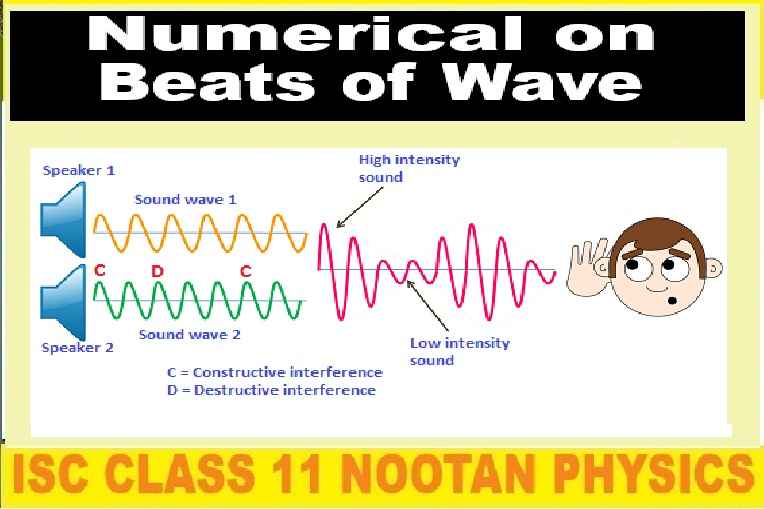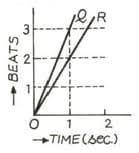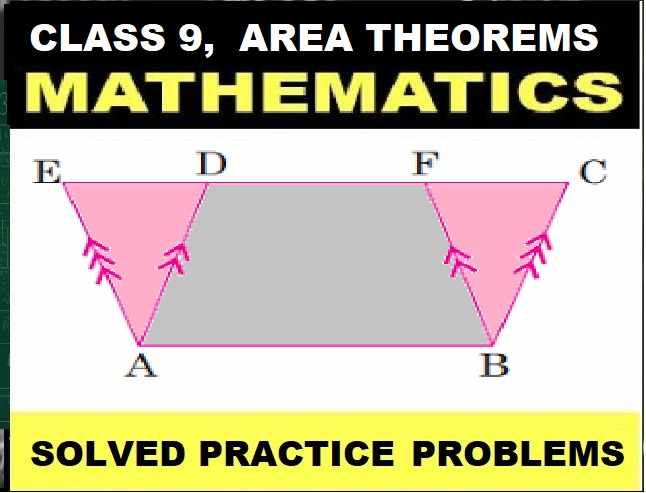Superposition of Waves Numerical on Beats Class-11 Nootan ISC Physics Ch-27 Step by step solutions of Kumar and Mittal Physics of Nageen Prakashan as council latest prescribe guideline for upcoming exam. Visit official Website CISCE for detail information about ISC Board Class-11 Physics.

Superposition of Waves Numerical on Beats Class-11 Nootan ISC Physics Ch-27
| Board | ISC |
| Class | 11 |
| Subject | Physics |
| Book | Nootan |
| Chapter-27 | Superposition of Waves-1 : Interference and Beats |
| Topics | Numericals on Beats of Wave |
| Academic Session | 2025-2026 |
Numericals on Beats of Wave
Class-11 Nootan ISC Physics Ch-27.solutions of Kumar and Mittal
Q-5: When two tuning forks are sounded together, sound of maximum intensity is heard successively at an interval of 0.2 s. Find out the difference in the frequencies of the tuning forks.
Ans- Suppose that the difference in the frequencies of tuning fork is n
n = beat frequency = 1 / t = 1 / 0.2 = 5 s^-1
Q-6: The period of vibration of a tuning fork is (1/288) second. When it is sounded with another tuning fork, 8 beats per second are produced. Determine the possible frequencies of the other fork.
Ans- T = 1 / 288 s
n = 1 / T = 1 / (1/288) = 288 Hz
No. of beats = 8
∴ Possible frequencies of other fork is 288 ± 8
that is 280 or 296 Hz
Q-7: The frequencies of two sound-sources are 512 and 516 Hz. What will be the time-interval between two consecutive beats produced by sounding them together?
Ans- Suppose that the time interval between two consecutive beat is
t = 1 / (n2 – n1) = 1 / (516 – 512) = 1/4 s
Q-8: Two tuning forks, on sounding together, produce 3 beats per second. The frequency of one is 256 Hz. On loading the other with a small wax, the number of beats per second becomes 5. What is the frequency of the other fork?
Ans- Beats = 3 beat/s n1 = 256 Hz
when on loading the other with a small wax the no. of beat increase then the frequency of other fork is 256 – 3 = 253 Hz
Q-9: Two tuning forks A and B are in unison. The frequency of B is 256 Hz. When the prongs of A are scraped by a file and sounded with B, then 4 beats per second are heard. What is the frequency of A after scraping?
Ans- When the prong of A are scraped by a file and 4 beats produced per second with B then the frequency of A = 256 + 4 = 260 Hz
Q-10: Two tuning forks produce 5 beats per second. The frequency of one is 256 Hz. When some wax is put on the prongs of the other one, the beats disappear. Find the frequency of the second fork.
Ans- When some wax is put on the prong of other the disappear then the frequency of second fork is 256 + 5 = 261 Hz
Q-11: Two tuning forks A and B are sounded together. The beats produced are shown by the straight line OQ in the graph. After putting wax on the tuning fork B, they are sounded together again. The beats produced are shown by the straight line OR. If the frequency of the tuning fork A is 341 hertz, calculate the frequency of the tuning fork B.

Ans- From fig. no. of beat Q = 3 R = 2
After putting the wax, beat decrease then frequency of tuning fork = 341 + 3 = 344 Hz
Q-12: The frequency of a tuning fork is 256 Hz. When it is sounded with another tuning fork, 3 heats per second are heard. When the second tuning fork is loaded with a small quantity of wax and sounded again with the first tuning fork, again 3 beats per second are heard. What is the frequency of the second tuning fork?
Ans- When the wax is putting on the fork (second) then frequency = 256 + 3 = 259 Hz
Q-13: The frequency of a tuning fork A is 256 Hz. When it is sounded with a tuning fork of unknown frequency, 4 beats per second are produced. When the prong of A is loaded with a small quantity of wax, only 1 beat per second is heard. If the prong of A is further loaded with wax, the number of beats per second is still 1. Determine the frequency of B. What is the final frequency of A?
Ans- when the prong of A is loaded with small of wax, the beat is decreases then the frequency of fork B is 256 – 4 = 252 Hz
when prong of A further load with wax then the final frequency of A = 252 – 1 = 251 Hz
Q-14: Two sitar strings A and B playing the note ‘Dha’ are slightly out of tune and produce beats of frequency 5 Hz. The tension of the string B is slightly increased and the beat frequency is found to reduce to 3 Hz. What is the original frequency of B, if the frequency of A is 427 Hz?
Ans- The no. of beat = 5 Hz
when the tension is increased of sitar B the beat frequency of 3 Hz I.e. decreased the frequency beat then original frequency of B = 427 – 5 = 422 Hz
Q-15: 26 tuning forks are arranged in the order of increasing frequency and any two successive forks give 4 beats per second when sounded together. If the frequency of the last fork is three times the frequency of the first fork, then calculate the frequency of the first fork.
Ans- Since 26 tuning forks are arranged in order of increasing frequency therefore 25 no. of beat arranged in order therefore Total no. of beats = 25 x 4 = 100 beats
ATQ n2 = 3 n1
=> n + 100 = 3n
=> 100 = 3n – n
=> n = 50 Hz
Q-16: The wavelengths of two waves are 49 and 50 cm. If the room temperature be 30°C, then how many beats per second will be heard due to these two waves? Velocity of sound at 0°C = 332 m s^-1.
Ans- We know that vt = vo + 0.61 t {given vo = 332 m/s , t= 30°C}
=> 332 + 0.61 x 30
=> 332 + 18.3 = 350.3 m/s
No. of beats = n1 – n2
=> v / λ1 – v / λ2 = v [1 / λ1 – 1 / λ2]
=> 350.3 [100 / 49 – 100 / 50] = 350.3 x 100 x 1 / (50 x 49)
=> 250.3 x 2 / 49 = 14 beats / s
Q-17: When, at 15°C, an air-column and a tuning fork are sounded together, 4 beats per second are produced. The frequency of the fork is less than that of the air- column. When the temperature falls to 10°C, then the number of beats per second decreases by 1. Determine the frequency of the fork. (Temperature-coefficient of sound, α = 0.0036 per °C).
Ans- Suppose that the frequency of the fork is n then the frequency of air column will be (n + 4) at 15°C and (n + 3) at 10°C
=> v15 / v10 = (n + 4) / (n + 3)
But, vt = vo (1 + 1/2 α t)
∴ v15 / v10 = [vo (1 + 1/2 α x 15)] / [vo (1 + 1/2 α x 10)] = [vo (2 + 15α)] / [vo (2 + 10 α)]
(n + 4) / (n + 3) = (2 + 15 α) / (2 + 10 α)
2n + 8 + 10 n α + 40 α = 2n + 6 + 15 n α + 45 α
2 – 5 α = 5 α n
n = (2 – 5 α) / 5 α = (2 – 5 x 0.0036) / (5 x 0.0038)
n = 2 – 0.018 / 0.018 = 1.982 / 0.018 = 1982 / 18 = 110 Hz
— : End of Superposition of Waves Numerical on Beats Class-11 Nootan ISC Physics Ch-27 :–
Return to : – – Nootan Solutions for ISC Physics Class-11
Thanks
Please share with your friends


